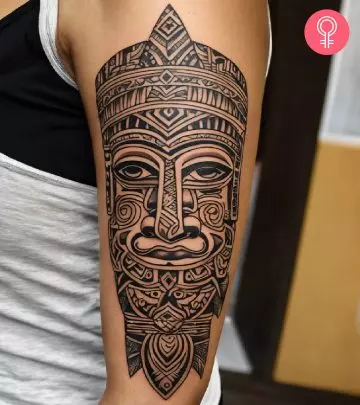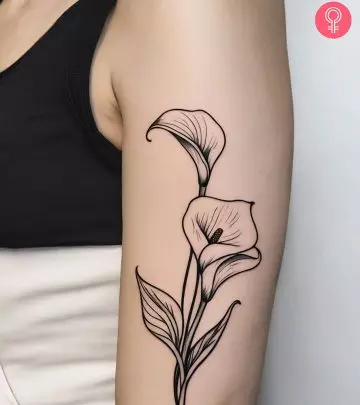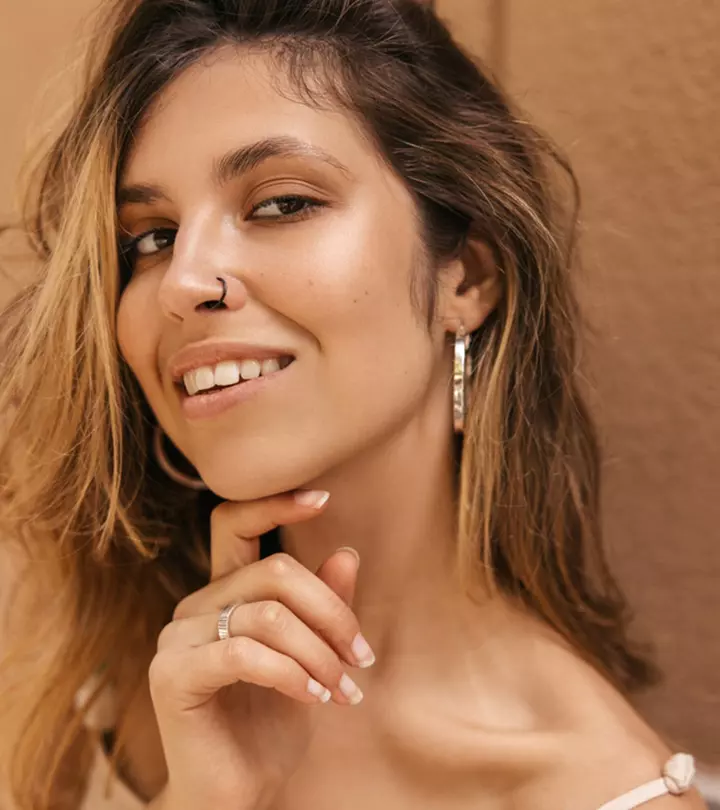Do Ear Piercings Close? The Facts You Need to Know
Discover if a temporary accessory break can impact that piercing in your ear.

Image: Midjourney/ StyleCraze Design Team
Body modifications like lobe, flat, helix, and orbital piercings are widely popular among people of all ages. Whether you style them with classic studs, hoops, or more intricate designs, they can be a versatile and fun way to enhance your personal style. However, this begs the question, do ear piercings close if you skip wearing your earrings for a few days? Well, some people assume that ear piercings never close. But that is not always the case. In this article, we will delve into factors that influence a closed ear piercing, how to reopen them, and more. Scroll down and get started.
In This Article
Do Ear Piercings Close?

Yes, ear piercings may close if they are left without earrings for an extended period. However, this depends on the individual and the piercing’s age. Typically, new piercings close up faster, whereas old piercings may shrink to some extent or close after a long period. The closure for both cases may be due to the body’s natural healing mechanisms, which can lead to the formation of new tissue (1).
 Did You Know?
Did You Know?There are many misconceptions surrounding ear piercings, particularly regarding their healing process and the possibility of them closing up. Discover if these myths are real or not in the section below.
Key Takeaways
- New ear piercings may close if left without earrings for an extended period, whereas older piercings are less likely to close completely but may shrink over time.
- Factors like the piercing age, gauge size, location, and infections may affect the piercing’s closure time.
- Avoid reopening a closed ear piercing forcefully, as it may turn it into an open wound and lead to infections.
- Wearing earrings daily and following aftercare guidelines may help prevent the piercing from closing and minimize the risk of infections.
Myths And Facts About Ear Piercings
Here are some common myths and facts about ear piercings to clear up any misconceptions:
Myth 1: All piercings close overnight.
Fact: While some piercings, typically newer ones, may close more quickly, it doesn’t always happen overnight. The healing time varies depending on factors like the location of the piercing and proper aftercare.
Myth 2: Older piercings never close.
Fact: Even older piercings can close, especially if the jewelry is removed for an extended period. The likelihood of a piercing closing depends on factors such as the age of the piercing and the thickness of the piercing channel.
Myth 3: Sea salt is the only effective way to clean piercings.
Fact: While sea salt can be beneficial for cleaning piercings, it is not the only option. Saline solutions and mild, unscented soaps are also effective.
Myth 4: You should never rotate your piercing jewelry.
Fact: Rotating your piercing jewelry gently and slowly may help prevent the skin from growing over it. However, avoid excessive twisting, as this can irritate the piercing.
Myth 5: Ear-piercing guns are safer than needles.
Fact: Guns can force jewelry through the skin too quickly, potentially causing tissue damage. Needles allow for more control and precision.
Myth 6: You should never remove your piercing jewelry.
Fact: While it is generally recommended to leave piercing jewelry in place for several weeks or months to allow the piercing to heal completely, there may be times when removal is necessary, such as for medical reasons or to switch out jewelry.
Whether your piercings are old or new, they may close up to some extent. But how long does it take for a piercing to close and what is the complete process like? Find out in the next section.
How Long Does It Take For An Ear Piercing To Close?
The closure time may vary from person to person. Some may experience rapid closure, while for others it may take months or even years before the piercing shrinks or disappears.
Another factor that plays a key role in the closure is the age of the piercing itself. For instance, removing starter earrings from brand-new piercings may lead to the hole closing up in a few days. This is because the jewelry acts as a boundary that helps the hole stay open while new tissues regenerate around the piercing during the healing period (2). While this is commonly seen in new piercings, old piercings received in childhood or earlier may take months or years to shrink or close completely.
Ultimately, your body’s response to the lack of earrings can vary and there is no assured timeline for the complete closure of your ear piercings, if at all. Apart from your piercing’s age, several other factors play a major role in determining its closure rate. Check out the next section to know more.
Factors Influencing The Closure Of Ear Piercings
Apart from your piercing’s age, here are some other factors that may contribute to increased ear piercing closure rates:
- Gauge Size
Gauge size refers to the thickness of the jewelry bar that can go into a piercing. Larger gauge sizes create larger holes in the tissue, which take longer to fill up, as compared to a smaller one. But irrespective of the gauge size, if you remove your starter jewelry before proper healing, the hole may close more quickly.
- Lack of Maintenance.
Failure to clean the piercing regularly can lead to infection and subsequent closure as the body attempts to heal the affected area.
- Not Wearing Jewelry For A Long Time
Leaving the piercing without jewelry for an extended period can cause the hole to close, as the body naturally heals any open wounds over time.
- Location

The location of the ear piercing may also affect its closing rate. For instance, lobe piercing takes longer to close due to the formation of fistulas (abnormal passageways between two body parts or organs) in the earlobes. Anecdotal evidence suggests that this abnormal connection between the skin tissue and blood vessels may indicate that your body has completely adapted to the piercing. As a result, it may not try to close the hole even without the earring.
Similarly, helix piercing may also take longer to close due to a limited blood supply in this area. Since higher blood flow is needed to stimulate the healing process and aid tissue reformation, that may not occur in the area (3). Further, people opting for a conch piercing or tragus piercing may find that the hole may not close after the healing process. Instead, the skin of the area may close over the pierced hole.
- Infections And Allergies
Improper aftercare or an allergic reaction to metals such as nickel may increase the risk of developing an infection or irritation (4). This may lead to inflammation, which in turn, may trigger the body’s natural response by closing the opening with new tissue (2).
Therefore, it is recommended to keep the piercing clean and choose jewelry material that you are not allergic to. Some options include gold, stainless steel, and sterling silver.
Any of the factors above may contribute to your ear piercing closing. But what do you do if it happens? Find out in the next section.
What To Do If You Think Your Piercing Hole Is Closed?
If you think your piercing hole is closed, the first thing you should do is resist the urge to break through the skin. This is because even a tiny tear in the tissue of your healed piercing can turn it into an open wound, which may lead to bleeding and increase the chances of infection. That said, you do not need to panic. Sometimes, a piercing may only appear closed due to some debris stuck in it. You can easily get rid of it by washing the piercing with a saline solution. Ensure you wash your hands with antibacterial soap and warm water before doing so.
Once you get the stuck debris out, you can easily slip in your favorite earrings without any worry. But if that does not work, check if you can get the stud bar even a little in. If so, you only need to replace it with a piece of jewelry with a thinner bar. You may use petroleum jelly to ease the process of wearing it. Once done, let the piece stay in for a few days or weeks before replacing it with your regular jewelry.
If the hole does not reopen or you experience pain, redness, or discharge, consult a professional piercer or healthcare provider for guidance. They can assess the situation and advise you on the best course of action, which may include reopening the piercing or providing additional care instructions. Remember that trying to reinsert jewelry into a closed piercing can cause injury or further irritation.
If this does not work also, chances are that your piercing may be partially closed. The good news is you can open it at home. Let us find out how in the section below.
How To Reopen A Partially Closed Ear Piercing Hole At Home

If your piercing hole is partially closed, fret not. Here are some simple steps you can follow to reopen it at home:
- Wash your hands with soap and water before touching the piercing to minimize the risk of introducing bacteria to it.
- Soak a cotton swab in a saline solution or antiseptic solution.
- Gently clean the front and back of the closed piercing to remove any debris.
- Take a warm shower or use a warm compress on the closed piercing for a few minutes to soften the tissue and make it easier to insert the jewelry.
- Boil a pair of earrings (preferably with a smaller gauge than your original piercing) in water for about 5 minutes to sterilize it. Let it cool before handling. You may also opt for a sterilized needle. However, ensure you handle it with care as it can tear your skin and cause it to bleed.
- Carefully insert the sterilized jewelry into the piercing with the help of a lubricant such as petroleum jelly or coconut oil to make the process smoother.
- If you encounter resistance or discomfort, do not force it. Instead, gently rotate the jewelry back and forth to help loosen the tissue in the area.
Once the jewelry is in, secure it, and clean it with a saline solution daily for a few days. Apart from this, avoid sleeping on the side of the reopened piercing to prevent irritation and keep an eye out for any signs of infection, such as increased redness, swelling, pain, or discharge. If you notice any of these signs, visit a reputable piercer or a healthcare specialist immediately.
Sade, a YouTuber, shared her experience of reopening her 4-year-old daughter’s closed ear piercing. She starts by poking the back of the piercing hole first with the earring to reopen it. According to her, doing so prevents any damage to it and is also pain-free. She says, “I start poking right there where the part is, and then I’ll stick through and turn it over and try to look to see where it’s sticking (i).” Once she breaks through the piercing, she removes the earring and sticks it through the front.
 Quick Tip
Quick TipIf your attempts to reopen the piercing are unsuccessful, you may have to visit a professional piercer. But is it possible to re-pierce a closed ear piercing? Find out in the following section.
Can You Re-Pierce A Closed Ear Piercing?

Yes, you can most likely re-pierce a closed ear piercing if it is completely healed. This may take around 2-3 months or more. However, only a professional piercer can help you determine if doing so is possible in your case. Usually, when a piercing hole closes, what grows back over it is the same tissue as before. This occurs due to the body’s natural healing ability (2). However, anecdotal evidence suggests that if your piercing is not completely healed, it may result in the formation of a raised area above the skin surface called scar tissue. This soft tissue is usually hyperpigmented and cannot completely repair normally (5). In such a case, your piercer may not re-pierce the area. Instead, they may make a new piercing very close to the old one, such that your earring covers the scar tissue.
Re-piercing ears after they have closed can be very annoying. So, what can you do to avoid it closing in the first place? Scroll down to know more.
What Can You Do To Avoid Ear Piercings Closing?

The first thing you need to do to prevent your ear piercing from closing is to wear earrings daily, without fail. This is especially necessary if your piercing is healing. Apart from this, you may do the following:
- Clean your ear piercings at least twice a day using a saline solution or a mild, fragrance-free soap and warm water. Pat them dry afterward to prevent the risk of infections.
- Gently rotate the earrings while cleaning to prevent them from sticking to the surrounding skin. However, avoid unnecessary twisting during the wound healing period.
- Wear high-quality jewelry made of materials such as surgical stainless steel, sterling silver, titanium, or gold. This will reduce the risk of allergic reactions.
All of this will ensure that you do not have to remove your jewelry. And, if you are wondering ‘when can I change my ear piercing?’, it is important to wait until the piercing is fully healed. This may take around 2-3 months in case of cartilage piercings and 6-8 weeks for earlobe piercings. However, even after this healing time, it is not recommended to go without your earring for days at a stretch.
The answer to the question, do ear piercings close, is not a straight yes or no. While individual experiences may vary, various factors like piercing age, gauge size, and location may affect its closure rates. Further, your body’s healing ability also plays a role in it. Therefore, the best you can do to prevent your piercing hole from closing up is to ensure you do not remove your earrings and thoroughly follow the aftercare guidelines given by your piercer. If you feel that your ear piercing has closed, do not try to force an earring in. Instead, visit a professional piercer, who can help you re-open or re-pierce it safely.
Frequently Asked Questions
Will my ear piercing close up overnight?
No, it is unlikely for your ear piercing to close up overnight. However, if your piercing is fresh, it is recommended to keep earrings in for several weeks or months to allow proper healing and minimize the chance of closure.
How long can I go without earrings before the holes close?
Anecdotal evidence suggests that you can go without earrings for a few weeks before the holes start to close, but it may take several months for them to fully close. However, this is just a general idea and is mostly applicable to healed piercings. It is not recommended to go without earrings when the piercing is in its healing stage.
If you have a partially closed ear piercing, fret not. it is possible to open it up at home with ease. Check out this video to understand the process better.
Personal Experience: Source
StyleCraze's articles are interwoven with authentic personal narratives that provide depth and resonance to our content. Below are the sources of the personal accounts referenced in this article.
(i) How to insert earrings through “closed” holes w/o pain
https://www.youtube.com/watch?v=GFS0Rg4oEJQ
References
Articles on StyleCraze are backed by verified information from peer-reviewed and academic research papers, reputed organizations, research institutions, and medical associations to ensure accuracy and relevance. Read our editorial policy to learn more.
- Factors affecting wound healing
https://www.ncbi.nlm.nih.gov/pmc/articles/PMC2903966/ - Wound healing – a literature review
https://www.ncbi.nlm.nih.gov/pmc/articles/PMC5087220/ - The influence of tissue oxygen and perfusion on wound healing
https://pubmed.ncbi.nlm.nih.gov/2223323/ - Nickel allergy
https://www.ncbi.nlm.nih.gov/books/NBK557638/ - Immunological mechanisms of scarring and their psychological impact on patients
https://www.ncbi.nlm.nih.gov/pmc/articles/PMC8610804/
Read full bio of Ikramul Haque Shazib
Read full bio of Gracia Odile
Read full bio of Eshna Das
Read full bio of Vaishali Sinha


























Community Experiences
Join the conversation and become a part of our empowering community! Share your stories, experiences, and insights to connect with other beauty, lifestyle, and health enthusiasts.